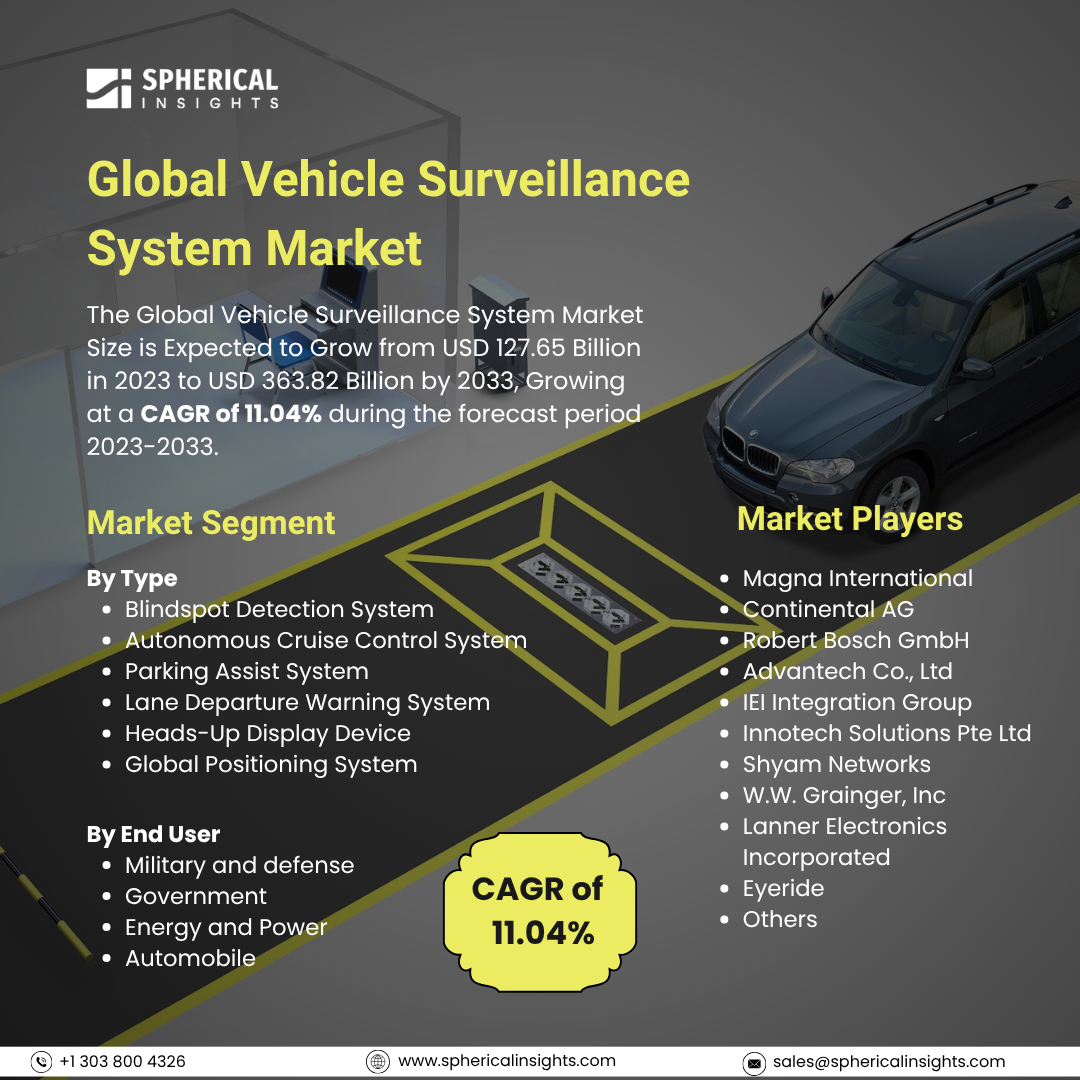Global Vehicle Surveillance System Market Size To Exceed USD 363.82 Billion By 2033
According to a research report published by Spherical Insights & Consulting, The Global Vehicle Surveillance System Market Size is Expected to Grow from USD 127.65 Billion in 2023 to USD 363.82 Billion by 2033, Growing at a CAGR of 11.04% during the forecast period 2023-2033.
Browse 210 market data Tables and 45 Figures spread through 190 Pages and in-depth TOC on the Global Vehicle Surveillance System Market Size, Share, and COVID-19 Impact Analysis, By Type (Blindspot Detection System, Autonomous Cruise Control System, Parking Assist System, Lane Departure Warning System, Heads-Up Display Device, Global Positioning System), By End User (Military and defense, Government, Energy and Power, Automobile), and By Region (North America, Europe, Asia-Pacific, Latin America, Middle East, and Africa), Analysis and Forecast 2023 - 2033
The international vehicle surveillance system market refers to the sector that focuses on the creation, manufacturing, and application of technology intended to track, record, evaluate, and monitor vehicle activity, both inside and outside of vehicles. These systems usually include parts like cameras, sensors, GPS, and software algorithms to improve driver and passenger safety, operational effectiveness, and vehicle security. Moreover, strict security regulations, the growth in car technologies, and the rising need for intelligent transportation systems are driving the industry. The growing emphasis on road safety laws and the growing uptake of smart mobility technologies contribute to the growth of the vehicle surveillance system market. However, the market expansion is constricted due to the high upfront cost for their ongoing maintenance.
The global positioning system segment held the greatest share of the global vehicle surveillance system market in 2023 and is anticipated to grow at a substantial CAGR over the forecast period.
On the basis of the type, the global vehicle surveillance system market is divided into blindspot detection system, autonomous cruise control system, parking assist system, lane departure warning system, heads-up display device, and global positioning system. Among these, the global positioning system segment held the greatest share of the global vehicle surveillance system market in 2023 and is anticipated to grow at a substantial CAGR over the forecast period. This segment growth is influenced due to real-time tracking, fleet management, vehicle navigation, theft recovery, and route optimization.
The military and defense segment accounted for a significant share of the global vehicle surveillance system market in 2023 and is expected to grow at a rapid pace over the forecast period.
On the basis of the end user, the global vehicle surveillance system market is classified into military and defense, government, energy and power, and automobile. Among these, the military and defense segment accounted for a significant share of the global vehicle surveillance system market in 2023 and is expected to grow at a rapid pace over the forecast period. This is due to the urgent requirement to enhance safety and monitoring in daily and suspicious activities.
Asia Pacific is anticipated to hold the largest share of the global vehicle surveillance system market over the forecast period.
Asia Pacific is projected to hold the greatest share of the global vehicle surveillance system market over the forecast period. The regional market growth is influenced by the rising car ownership in emerging economies like China and India, use of sophisticated in-car monitoring systems. Concurrently, government programs to upgrade road infrastructure and lower accident rates, as well as increased public awareness of vehicle safety, propel the market growth.
North America is expected to grow at the fastest CAGR of the global vehicle surveillance system market over the forecast period. The regional market growth is accelerated by increased worries about road safety, car theft, and regulatory requirements for fleet monitoring, and systems have become widely integrated into both the commercial and personal sectors. The region's adoption of vehicle surveillance systems has been further driven by the growing technological prevalence of linked and autonomous vehicles with highly developed automotive infrastructure.
Company Profiling
Major vendors in the global vehicle surveillance system market are Magna International, Continental AG, Robert Bosch GmbH, Advantech Co., ltd, IEI Integration group, Innotech Solutions pte ltd, Shyam Networks, W.W. Grainger, Inc, Lanner Electronics Incorporated, Eyeride, and others.
Key Target Audience
- Market Players
- Investors
- End-users
- Government Authorities
- Consulting And Research Firm
- Venture capitalists
- Value-Added Resellers (VARs)
Recent Development
- In March 2022, Teledyne FLIR Defense launched its lightweight vehicle surveillance system (LVSS), equipped with advanced air domain awareness (ADA) and counter-unmanned aerial system (C-UAS) capabilities. This innovative system combined 3D radar, EO/IR cameras, and RF detection sensors to deliver early warnings and counter drone threats, including drone swarms. The LVSS was designed for rapid deployment, offering perimeter protection and enhanced video analytics for precise threat identification.
Market Segment
This study forecasts revenue at global, regional, and country levels from 2023 to 2033. Spherical Insights has segmented the global vehicle surveillance system market based on the below-mentioned segments:
Global Vehicle Surveillance System Market, By Type
- Blindspot Detection System
- Autonomous Cruise Control System
- Parking Assist System
- Lane Departure Warning System
- Heads-Up Display Device
- Global Positioning System
Global Vehicle Surveillance System Market, By End User
- Military and defense
- Government
- Energy and Power
- Automobile
Global Vehicle Surveillance System Market, By Regional
- North America
- Europe
- Germany
- UK
- France
- Italy
- Spain
- Russia
- Rest of Europe
- Asia Pacific
- China
- Japan
- India
- South Korea
- Australia
- Rest of Asia Pacific
- South America
- Brazil
- Argentina
- Rest of South America
- Middle East & Africa
- UAE
- Saudi Arabia
- Qatar
- South Africa
- Rest of the Middle East & Africa



